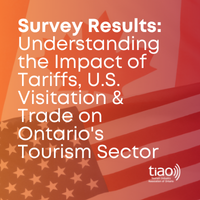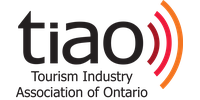
Tourism Industry Association of Ontario (TIAO) conducted a province-wide survey in September 2025 to evaluate how tariffs and the Canada–U.S. trade dispute shaped tourism business performance during the 2025 summer season. The survey captured responses from operators across all regions, sectors, and business sizes, exploring changes in visitation, spending, and confidence year-over-year for the months of June, July, and August.
Total Sales
- 75% of respondents reported comparable total sales year-over-year (2025 vs. 2024)
- 7% reported higher sales
- 11% reported lower sales
A majority of operators maintained stable sales compared to 2024, despite significant cost pressures and broader economic uncertainty.
Visitor Volumes by Market Category
Leisure Travel (year-over-year):
- Ontario: 44% higher, 20% lower
- Canada (outside Ontario): 35% higher, 17% lower
- U.S.: 26% higher, 26% lower
- Overseas: 38% higher, 17% lower
Business Travel (year-over-year):
- Ontario: 15% higher, 22% lower
- Canada: 7% higher, 18% lower
- U.S.: 2% higher, 27% lower
- Overseas: 2% higher, 11% lower
Commentary:
Survey respondents noted that domestic visitation within Ontario saw their strongest gains, followed by growth from other Canadian markets. However, approximately one fifth of operators still reported declines in these same categories, indicating uneven regional recovery. U.S. visitation remained flat overall, though these results were stronger than expected given pre-season forecasts. Business travel volumes among respondents lagged across all market categories, with domestic business travel performing relatively better than U.S. or overseas segments.
Sales Performance by Market Category
Leisure Travel (year-over-year):
- Ontario: 50% higher, 26% lower
- Canada: 28% higher, 16% lower
- U.S.: 24% higher, 31% lower
- Overseas: 36% higher, 12% lower
Business Travel (year over year):
- Ontario: 15% higher, 15% lower
- Canada: 10% higher, 15% lower
- U.S.: 3% higher, 28% lower
- Overseas: 3% higher, 13% lower
Commentary:
Survey respondents noted that spending from Ontario visitors showed the strongest gains, with half of operators reporting higher domestic leisure spending. Overseas spending also increased substantially. U.S. visitor spending, however, declined overall, likely reflecting reduced same-day, drive-market travel, and lower consumer confidence. Business travel spending remained flat domestically and lower across all international markets.
Perceived Impact of the Canada–U.S. Trade and Tariff Dispute
(Visitation and spending impact for June–August 2025):
- 22% Significant
- 45% Somewhat significant
- 12% Neutral • 16% Not likely
- 8% Not at all
Operator Observations:
- U.S. visitors often expressed goodwill and even apologized for political tensions, though some conveyed unease about how they might be received in Canada.
- Domestic travel and spending outperformed 2024 levels, but operators observed more shorter stays, last-minute bookings, and lower discretionary spending— signs of ongoing consumer caution.
- Domestic gains were largely attributed to Canadians choosing to vacation at home rather than travel to the U.S.
Other Factors Affecting Business Performance (Summer 2025)
- Operational Inflation: Rising food, energy, and supply costs continued to squeeze margins.
- Climate Change: Over half of respondents reported impacts from extreme weather, including heat waves, drought, wildfire smoke, and fire bans, that disrupted outdoor activities and reduced booking predictability. Many noted related shorter winter and shoulder seasons, requiring adjustments in business models.
- Labour Shortages: Persistent staffing gaps remain, exacerbated by the reduction in international student numbers and paused tourism, hospitality, and culinary programs, especially in rural areas.
- Post-Pandemic Recovery: Several operators continue to work toward matching pre-pandemic performance levels and managing debt costs, with lingering effects of past border closures on cross-border travel.
Business Costs and Adaptations
- 86% of respondents reported increased operating costs linked to tariffs and counter-tariffs.
- 32% cited reduced product availability and customs-related delays.
Key Business Adaptations
- 50% sought new suppliers to replace U.S. sources
- 48% increased domestic and Canadian-made product sourcing
- 43% Launched new marketing campaigns to reach different customer demographics
- 32% increased prices
- 24% Changed or diversified offerings
- 21% Reduced expenses
- 19% Paused or cancelled planned investments
These adaptive measures demonstrate significant resilience, including ability to shift toward domestic supply chains and to adapt business models to meet economic conditions.
Outlook and Confidence
Expectations for Fall 2025 largely mirror summer performance. 61% of respondents expressed confidence in their 12-month outlook, driven by:
- Early 2026 bookings already confirmed
- Loyal customer bases and resilient market segments
- A proven ability to adapt amid uncertainty
However, optimism is tempered by continued exposure to rising costs, workforce instability, political and trade risks, climate-related disruptions, and local infrastructure challenges.
Priority Recommendations
Respondents identified several areas where government and industry action would have the greatest impact:
- Marketing and Visitor Attraction (83%) – Expand promotional initiatives across all market types and scales, including digital readiness programs for operators, to ensure equitable benefit for gateway cities, mid-sized communities, and rural destinations. Focus on market diversification and business event attraction.
- Financial Supports (77%) – Introduce grants, subsidies, tax relief, or low interest loans to offset rising costs, address pandemic-related debt, reduce small business burdens, and to stimulate business investment and climate adaptation measures.
- Workforce and Immigration (19%) – Develop more robust training programs, immigration pathways, and foreign worker flexibility tailored to seasonal and rural operators.
Summary and Key Insights
- Domestic markets were the strongest contributors to Summer 2025 results for respondents.
- Overseas visitation and spending show promising growth opportunities.
- U.S. visitation performed better than expected in aggregate but remains below potential and uneven across the province, ongoing engagement with this market is crucial given continued positive sentiment noted.
- Leisure travel among respondents performed more strongly than business travel, which remains subdued. Efforts to stimulate business travel remain a key priority.
- Consumer confidence is improving but remains cautious, with shorter trips and lower discretionary spending patterns.
- Cost pressures and supply chain disruptions continue to challenge operators, prompting widespread innovation and adaptation.
- Operators are increasingly sourcing from Canadian suppliers, reinforcing the value of a “Made-in-Canada” tourism economy.
- Climate change, labour shortages, and lingering debt remain critical factors shaping 2025 outcomes, which are expected to carry forward.
- Business outlook is cautiously optimistic, dependent on continued investments and supports to diversify markets, stabilize workforce conditions, reduce business costs, and stimulate supply-chain and business investment.
Survey respondents demonstrate adaptability, creativity, and perseverance in the face of global uncertainty. Their recommendations for policy support and investment align closely with the new Strategic Playbook for Ontario’s Tourism Industry, which aims to champion targeted action and investments to sustain growth, deepen resilience, and reinforce tourism’s vital role in Ontario’s economy.
